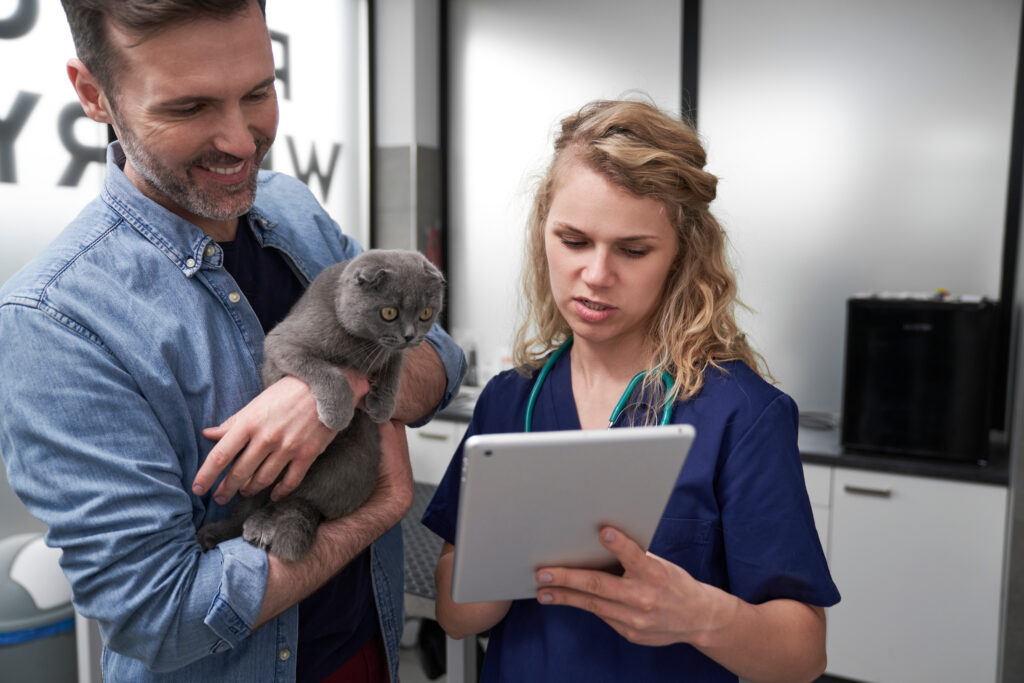Boost Your Veterinary Practice with AI: ChatGPT’s Hidden Powers
Boost Your Veterinary Practice with AI: ChatGPT’s Hidden Powers
What is ChatGPT?
Think of it as a superpowered chatbot capable of improving efficiency, reducing wait times, and enhancing customer service – all while freeing up time for you and your staff. ChatGPT is an AI-driven tool that provides natural language responses to inquiries using a deep learning model developed by OpenAI. Unlike basic chatbots, it understands context and nuances in human language, allowing for more relevant interactions. However, it’s important to note that ChatGPT cannot provide medical or veterinary advice. Instead, it serves as an assistant for handling administrative tasks, client communication, and operational support.

Essentially, ChatGPT functions as a virtual assistant available 24/7 to support tasks such as scheduling appointments, answering general queries about services, and streamlining practice operations.
Applications of ChatGPT in Veterinary Practices
Integrating ChatGPT into your veterinary practice can unlock numerous benefits. It is a valuable tool for improving marketing efforts, enhancing customer service, and increasing operational efficiency.
Marketing & Growth
When it comes to marketing, ChatGPT can help generate ideas for social media content by providing insights into trending topics and client interests. This allows practices to develop engaging campaigns that resonate with their audience, ultimately boosting engagement and brand awareness.
Another powerful capability is its ability to assist with targeted paid advertising. With an overview of your target audience, ChatGPT can help define advertising parameters such as geographic location, pet ownership history, and specific pet care needs—helping you create more effective and targeted campaigns.
Customer Service
ChatGPT can significantly enhance client interactions by providing immediate responses to general inquiries via a chatbot on your website or social media platforms. While it cannot give veterinary advice, it can answer routine questions about practice hours, services offered, and appointment availability.
Additionally, ChatGPT can assist staff in creating customer resources. Your team can input raw information, and ChatGPT can help structure it into clear, user-friendly documents, such as post-surgery care instructions or FAQs about prescription refills.
Operational Efficiency
As a virtual assistant, ChatGPT can help streamline various administrative tasks. For example, it can assist with scheduling appointments by checking availability and sending confirmation details to clients. It can also facilitate prescription refill requests by gathering necessary information, verifying details with the veterinarian, and processing the order.
In addition, ChatGPT can help analyze inventory levels if integrated with your practice management system, identifying items that need replenishing and optimizing ordering processes.
5 Things You Didn’t Know ChatGPT Can Do
While ChatGPT is often seen as a tool for customer service and administrative tasks, its capabilities extend beyond just answering questions and scheduling appointments. Here are five surprising ways ChatGPT can make your veterinary practice even more efficient:
- Create Different Client Personas for Tailored Interactions
ChatGPT can help you create detailed client personas based on factors like pet ownership habits, client preferences, and specific needs. These personas can be used for more than just marketing—such as personalizing client communications, improving service delivery, and guiding staff interactions. - Break Down Meeting Notes into Digestible Bullet Points
After a long meeting, ChatGPT can assist by summarizing key points and converting them into clear, concise bullet points. This saves time and helps you focus on the actionable takeaways without having to sift through lengthy notes. - Help with Creative Post Ideas for Social Media
Struggling to come up with new ideas for your social media channels? ChatGPT can generate creative concepts, suggest engaging questions, and recommend trending topics to share with your audience. - Summarize and Extract Key Information from Larger Passages
ChatGPT can quickly digest long documents, articles, or research papers, and provide concise summaries of the most important information. - Enhance Client Interaction with Personalized Responses
ChatGPT can be used to craft personalized responses to client inquiries based on the specific context and needs of each client. Whether it’s a response to an email, a follow-up after an appointment, or a custom answer to a client’s specific concern, ChatGPT can help ensure your communications are thoughtful, timely, and tailored to each individual.
Best Practices for Using ChatGPT in Veterinary Practices
To maximize the benefits of ChatGPT, it’s important to implement it strategically while keeping its limitations in mind. Here are some best practices to follow:
- Understand ChatGPT’s Capabilities
To fully leverage ChatGPT, take the time to explore its features and functionalities. Stay informed by attending industry webinars, reading AI-related publications, and keeping up with updates on chatbot technology. - Train Your Staff
Provide training sessions for staff members to ensure they know how to use ChatGPT effectively. This could include best practices for inputting queries, using specific prompts for optimal results, and understanding the limitations of AI assistance. - Set Clear Goals
Before integrating ChatGPT, define your objectives. Do you want to improve customer satisfaction, increase appointment bookings, or reduce administrative workload? Setting clear goals will help measure its effectiveness and guide adjustments in your approach. - Stay Updated on AI Developments
AI technology is constantly evolving, and ChatGPT continues to receive updates and enhancements. Keeping up with these advancements will help you maximize its potential and adapt it to better suit your practice’s needs.
Conclusion
ChatGPT is a powerful tool that can enhance efficiency in veterinary practices by streamlining administrative tasks, improving customer interactions, and supporting marketing efforts. While it cannot provide medical or veterinary advice, it can assist in various operational functions, allowing veterinary professionals to focus more on patient care.
By strategically incorporating ChatGPT into your practice, you can improve service quality, optimize workflows, and save valuable time for both staff and clients.